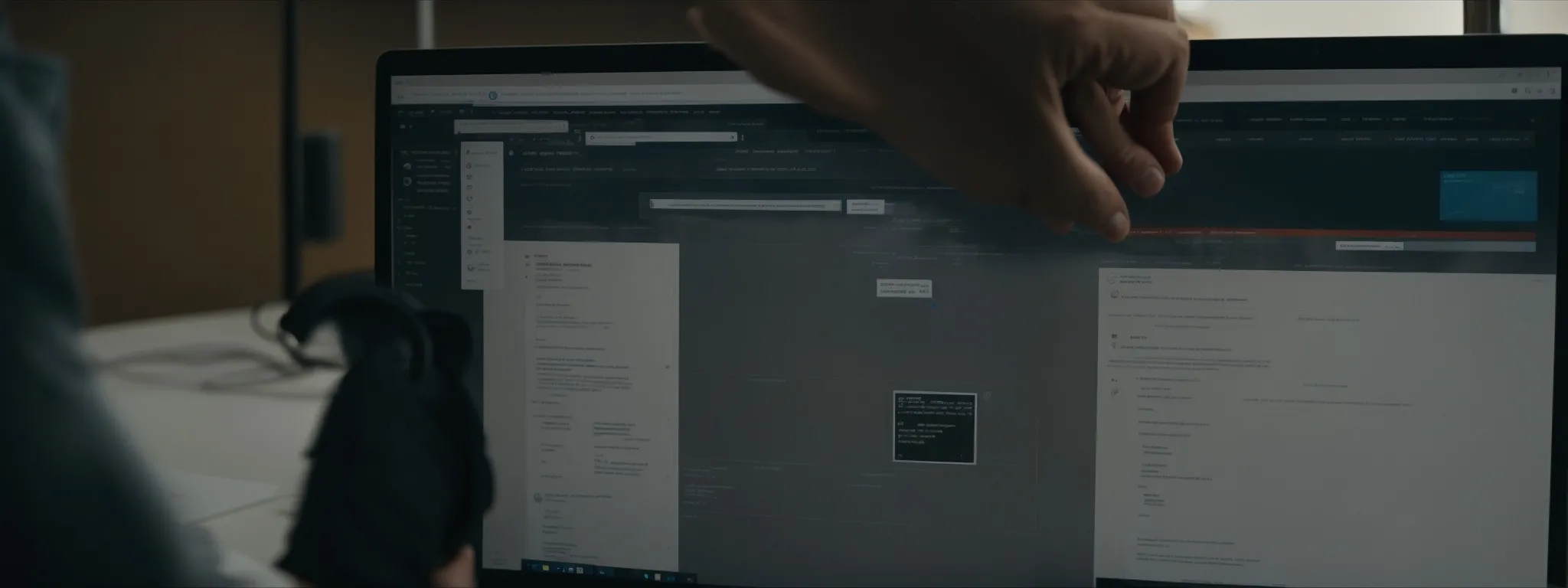Does Url Length Affect SEO
The Impact of URL Length on SEO Performance When delving into the realm of search engine optimization, experts often scrutinize the impact of URL length on SEO […]
The Impact of URL Length on SEO Performance
When delving into the realm of search engine optimization, experts often scrutinize the impact of URL length on SEO performance.
A common question that arises is whether shorter URLs facilitate better search ranking and user experience.
With LinkGraph’s cutting-edge SEO services and the Search Atlas SEO tool at their disposal, clients gain insights that demystify SEO myths, such as the contentious debate surrounding URL length and its influence on web page visibility.
LinkGraph’s expertise illuminates the intricate dance between the brevity of a URL and the clarity it offers to both visitors and search engines.
Keep reading to uncover how optimizing your URL structure can propel your site to superior search results.
Key Takeaways
- URL Length Plays a Role in SEO, but Relevance and User Experience Are More Critical
- LinkGraph Uses Advanced SEO Tools to Balance URL Structure With Search Engine Best Practices
- Strategic Keyword Inclusion in URLs Boosts Search Relevance and Aligns With Searcher Intent
- A Well-Organized URL Structure Aids in Site Indexing and Improves User Navigation
- As SEO Evolves, the Emphasis on URL Length May Decline in Favor of Semantic Search Relevance
Exploring the Significance of URL Length in SEO

Within the landscape of Search Engine Optimization, professionals constantly evaluate myriad factors for their impact on search ranking.
One such element under scrutiny is URL length; a subject that has spawned various schools of thought regarding its influence on Search Engine Algorithms.
As businesses strive to optimize their digital assets, understanding the implications of URL structure, including subdirectories and URL slugs, becomes a cornerstone of effective strategy.
LinkGraph, a frontrunner in The SEO Industry, examines the nuances between short and long URLs to inform and enhance the visibility of clients in the search results.
This exploration is critical, as it can significantly dictate how easily a searcher locates and interacts with a web page from the vast array of listings within a search engine results page (SERP).
Deciphering SEO Implications of Short vs Long URLs
LinkGraph meticulously dissects the ongoing debate surrounding URL length and its effect on SEO. Distilling this dense topic, experts consider whether extensive URLs, with their potential for increased keywords, Outweigh simpler, more concise alternatives that users might better digest and recall.
With the evolving algorithms of search engines, the impact of URL length on search ranking remains a dynamic topic. LinkGraph leverages its mastery to discern patterns that might suggest a longer URL, replete with hyphens, letters, and additional descriptors, improves user experience by providing clearer breadcrumbs or if it may inadvertently complicate navigation and deter website visitors.
How URL Length May Influence Search Engine Visibility
Visibility on search engines can be deeply intertwined with the structure of a URL. Experts at LinkGraph assert that the clarity of a URL can impact Search Engine Crawlers‘ ability to index and understand page content effectively: ensuring a website’s pages are properly represented within search results.
- Crawlers prefer clarity and context that align with a user’s search intent.
- A well-structured URL gives search engines clear indicators of the page content, aiding in the indexing process.
- Organized subfolders and subdirectories can signal the hierarchy and relevance of content on a website.
Conversely, URLs that are overly verbose or stuffed with unnecessary words could diminish a web page’s chances of occupying a coveted spot on SERPs. LinkGraph tailors its SEO Services to strike an optimal balance; optimizing URL length to be concise without sacrificing descriptive value that supports user experience and search ranking.
Length Matters: How URL Size Affects SEO Rankings

The digital marketing realm frequently revisits the question of whether the measure of a URL can swing the pendulum of search engine visibility.
Spirited discussions have unfolded among SEO professionals on the topic of URL length and its potential correlation with positioning on the Search Engine Results Page (SERP).
LinkGraph, committed to the meticulous analysis of search ranking factors, provides clarity and strategic direction by examining the intertwining relationship between URL length and its influence on SERP standings.
This topic is not only concerned with numerical length but also encompasses the quality and relevancy that Google attributes to URL structure in the broader context of user experience and site navigation.
Analyzing the Correlation Between URL Length and SERP Positions
LinkGraph meticulously examines the SEO community’s findings that suggest shorter URLs may enhance a Site’s SERP Positioning due to their greater memorability and ease of sharing among users. The SEO firm’s rigorous analysis points toward a definitive trend: websites sporting succinct, clear page addresses often perform better in user engagement metrics, which indirectly influences search rankings.
Integrating advanced SEO toolsets, such as Search Atlas, LinkGraph identifies whether the correlation between a tight, neat URL structure and higher search visibility holds empirical weight. This practice permits clients to refine their domain name strategy, ensuring their URL slugs align not only with their brand but also with Google’s best practices for effective search engine optimization.
Understanding Google’s Perspective on URL Length
Google’s John Mueller has iterated that URL length is a secondary feature; the search giant’s algorithms primarily focus on the content and user experience offered by a page. LinkGraph integrates this insight into its strategy, indicating that while URLs should be succinct, overall site performance and relevancy hold the keys to optimizing a client’s search ranking.
The coherence of a website’s URL structure is another aspect emphasized by Google, where clarity in the address bar can facilitate better understanding and indexing by crawlers. Acknowledging this aspect, LinkGraph ensures that clients benefit from URLs that are thoughtfully constructed to align with the searcher’s intent, connecting user queries to the appropriate content without undue complexity.
Optimizing URL Length for Better SEO Performance

Mastering the art of URL optimization is a critical skill for enhancing a website’s SEO performance.
Crafting a URL that is both concise and rich in informational value poses a challenge for many enterprises, yet it is a challenge that must be met to facilitate better search engine indexing and user engagement.
In the pursuit of an optimized online presence, LinkGraph offers strategic insights into the art of URL refinement.
Exploring methods to distill URLs to their essence without compromising their informative nature, as well as the judicious application of URL shorteners, the following insights provide a roadmap to improved search visibility and enhanced user experience.
Tips for Trimming URLs Without Losing Informational Value
To accomplish URL optimization while preserving informational value, a meticulous approach is paramount. LinkGraph advocates for the surgical removal of superfluous parameters and filler words that add little to no semantic weight to the URL, thereby streamlining the page address while maintaining its descriptive integrity.
Strategic selection of keywords is also essential; identifying and integrating terms that users are likely to echo in their search queries can refine URL structure. This practice aids search engines in correlating the user’s intent with the content presented on the website:
- Analyze the most relevant keywords for your content and integrate them into your URL where appropriate.
- Eliminate redundant or non-essential words that do not contribute to a searcher’s understanding.
- Use hyphens to separate words in the URL slug, enhancing readability and search engine crawlers’ parsing ability.
Strategic Use of URL Shorteners and Their Impact on SEO
The strategic application of URL shorteners can be an effective tactic in the arsenal of SEO optimization. LinkGraph recognizes that compact URLs, generated through shorteners, may enhance shareability and readability, provided they are used judiciously to maintain the integrity of the original URL and not mask relevant information.
LinkGraph’s expertise underscores that while URL shorteners facilitate tidier, more manageable links for promotional purposes, their overuse must be carefully avoided to prevent dilution of SEO efforts. These tools should complement a robust SEO strategy that prioritizes organic search performance and clear link attribution, especially in tracking and analytics operations.
Does Shorter URL Mean Higher Ranking Potential?

The digital marketing sector is rife with discussions on the influence of URL length on a website’s SEO performance, sparking debates that oscillate between fact and fiction.
Amidst the scrutiny, professionals must disentangle the complexities that surround URL structure and its correlation with search engine rankings.
LinkGraph stands at the forefront of this exploration, aiming to demystify the SEO implications of URL dimensions and providing empirical evidence to illuminate the real-world impact on search visibility.
Continuing this conversation, the following discourse seeks to debunk prevalent myths and showcase tangible examples of how URL length can shape a website’s SEO trajectory.
Debunking Myths About URL Length and Search Rankings
LinkGraph spearheads the initiative to unravel prevalent misconceptions, revealing that the connection between URL length and search rankings is more nuanced than many assume. Their comprehensive analysis debunks the SEO myth that equates shorter URLs with an automatic boost in search engine visibility, emphasizing instead the importance of relevance and user experience within URL structure.
The firm’s rigorous research indicates that while excessively long URLs may challenge user experience and complicate crawler indexing, a URL’s length by itself is not a primary metric for search engines in ranking web pages. LinkGraph’s informed perspective guides clients to focus on creating concise yet descriptive URLs that align closely with searchers’ queries and intentions.
Real-World Examples of URL Length Affecting SEO
Practical experiences shed light on the complexity of URL length in real-world SEO scenarios. In a case study, LinkGraph evaluated the performance of two identical pages, differentiated only by their URL length; the page with a concise and descriptive URL outperformed its longer counterpart in search rankings, underpinning the idea that brevity combined with relevance tends to resonate better with search engine algorithms.
Another instance involves an extensive overhaul of a client’s website structure by LinkGraph, streamlining bloated URLs into more succinct versions. Post-implementation, the client witnessed not only a hike in their SERP positions but also an uptick in visitor retention and interaction, illustrating the potential impact of URL optimization on user experience and search engine favorability:
- The reduction of URL length led to improved crawler efficiency and more accurate indexing.
- Cleaner URLs facilitated higher engagement and easier sharing across social platforms.
- Elevated user experience was reflected in reduced bounce rates and enhanced conversion metrics.
Ideal URL Length: A Deep Dive Into SEO Best Practices

In the realm of search engine optimization, the debate over the ideal URL length is a persistent one.
Experts advocate for a balance that leverages brevity to benefit user experience while including sufficient detail to convey the content’s context.
A meticulously crafted URL not only steers clear of common pitfalls but also serves as a vital cog in the SEO machine, potentially elevating a site’s prominence in search rankings.
In the following sections, LinkGraph offers a precise synthesis of expert recommendations and strategies to help clients navigate the complexities of URL length.
This ensures that each URL is a tailored beacon, guiding searchers efficiently to their desired destination and improving site performance metrics.
Expert Recommendations for Crafting Optimally-Sized URLs
In consulting with industry leaders, LinkGraph’s SEO professionals recommend that an ideal URL should succinctly reflect the core topic of a web page while avoiding unnecessary filler. This approach fosters a user-friendly experience by ensuring that visitors can easily interpret and recall the web page’s address.
Furthermore, LinkGraph emphasizes that strategic keyword inclusion enhances both user understanding and search engine indexing:
- Ensuring keywords are relevant and add context,
- Avoiding keyword stuffing, which could harm user perception and search ranking,
- Keeping URLs to a reasonable length to improve memorability and ease of sharing.
Common Pitfalls in URL Length and How to Avoid Them
In tackling the complexities of URL length, LinkGraph identifies common pitfalls such as excessively lengthy URLs, which may deter user interaction and pose challenges for search engine crawlers. By advising against elongated strings of alphanumeric characters and irrelevant descriptors, LinkGraph steers clients towards crafting URLs that are navigable and succinct, thus improving the user’s experience and a website’s SEO positioning.
Furthermore, LinkGraph cautions against the overuse of hyphens and subdirectories, which can clutter a URL and obscure its purpose. Through expert analysis, LinkGraph aids clients in constructing clean, straightforward URLs that accurately reflect the content of the web page, enhancing search engine recognition and ensuring a seamless user journey from the search results to the website.
User Experience and URL Length: Finding the Balance

As LinkGraph delves into the intricacies of search engine optimization, a critical aspect emerges: the harmony between URL length and user experience.
In the quest to bolster SEO performance, the impact of URL structure on the end-user’s interaction and website navigation cannot be overstated.
To that end, assessing how URL clarity influences the user’s journey aligns directly with the efficacy of SEO efforts.
Hence, it is imperative to balance the mechanics of SEO with the real-time responses of those seeking information—understanding that the user’s encounter with a URL can either streamline their experience or lead to undue friction.
Assessing the User’s Perspective on URL Length and Clarity
In the panoramic view of search engine optimization, user perspective on URL length and clarity becomes an influential factor. As LinkGraph delves into optimization strategies, the users’ interaction with URLs in the address bar guides their seamless navigation through a digital landscape that favors brevity and precision.
The clarity of a URL directly affects how quickly and accurately a visitor can predict the content they will encounter on a given page: a critical determinant in the enhancement of user experience and search engine relevance. To illustrate this point:
- A URL replete with clarity instills a sense of trust and aids in visitor retention.
- Conversely, URLs that are unnecessarily complex or ambiguous may lead to confusion and a higher bounce rate.
- Ultimately, LinkGraph ensures every URL structure aligns with the intuitive expectations of the end-user, bolstering engagement and SEO potential.
Balancing URL Length for SEO Success and User Satisfaction
In navigating the confluence of SEO and user experience, LinkGraph acutely recognizes the importance of moderating URL length. Crafting URLs that foster both search engine favorability and user satisfaction requires a deft touch, seamlessly integrating brevity with comprehensiveness to enrich a user’s online journey.
LinkGraph’s strategic approach harmonizes SEO best practices with the pragmatic needs of users, ensuring that URLs are not only conducive to higher search rankings but also facilitate ease and clarity of navigation. This optimization translates into a potent synergy, resulting in a user-centric browsing experience that complements the overarching goals of robust search engine visibility.
Beyond Length: Additional URL Factors Influencing SEO

While the length of a URL is an important consideration in search engine optimization, it is not the sole element that dictates a website’s SEO performance.
The integration of keywords into URLs often serves as a pivotal signal to search engines, articulating the content and context of web pages.
Concurrently, the overarching URL structure, including the configuration of subdirectories and strategic positioning of keywords, plays a critical role in mapping a clear pathway for both search engine crawlers and users.
Such meticulous attention to URL details fortifies the foundation upon which SEO efficacy is built, transcending mere brevity to embrace the multifaceted nature of search optimization.
The Role of Keyword Inclusion in URLs for Enhanced SEO
Enhancing SEO through keyword inclusion in URLs is a strategic approach implemented by LinkGraph, recognizing that keywords serve not just as a guide for content but as signposts for search engines. When a URL encapsulates relevant and targeted keywords, it signals the thematic substance of the web page to both users and search algorithms, thereby optimizing search visibility.
Integrating keywords that mirror the searcher’s query boosts the relevance signal for search engines, which can translate into improved search ranking. LinkGraph employs this tactic to craft URLs that are more likely to align with searcher intent and drive meaningful traffic to clients’ websites:
- Identify core keywords that are central to the web page’s content.
- Embed these keywords strategically within the URL to preserve readability.
- Ensure that keyword placement feels natural and improves user understanding.
Understanding the Impact of URL Structure on SEO Alongside Length
LinkGraph elucidates that in search engine optimization, the architecture of a URL is just as important as its length. This structure, encompassing subdirectories and the strategic arrangement of keywords, serves to convey a distinct hierarchy and topical relevance to search engines, thereby strengthening indexation and user understanding.
The interplay between URL structure and search engine algorithms is pivotal; a coherent, well-designed URL structure promotes cleaner navigation for users and facilitates the efficient crawling by search engine bots. The implementation of SEO-friendly URL construction can markedly elevate a domain’s visibility and relevancy within the digital realm:
- Organized URL structure leads to improved site indexing and user-centric navigation.
- Strategically placed keywords within the URL signal content themes to search engines.
- A clear hierarchy in URL designates aids in defining content significance and relevance.
The Future of URL Length in Evolving SEO Strategies

As the algorithms underpinning search engine optimization continue to advance, the criteria affecting a site’s SEO performance evolve accordingly.
Within this dynamic arena, the influence of URL length on a site’s searchability and user engagement remains a subject ripe for debate.
LinkGraph closely monitors the shifting sands of SEO best practices, preparing to navigate any forthcoming adjustments in how URL length is factored into the search ranking equation.
This ongoing vigilance primes businesses for potential paradigm shifts, equipping them to respond adeptly to emerging SEO trends and the consequent redefinition of URL length’s importance.
Predicting Shifts in SEO Approaches Towards URL Length
As search engines refine their algorithms, LinkGraph anticipates potential modifications in the weight assigned to URL length within SEO strategies. The industry is poised to observe how enhancements in machine learning and artificial intelligence may recalibrate the importance of URL precision in favor of semantic understanding and user engagement.
LinkGraph remains at the helm of adaptive SEO tactics, ready to embrace and implement new guidelines that may emerge from search engine evolutions. The SEO service provider vigilantly tracks these developments, ensuring that any shifts towards a more nuanced appreciation of URL length are seamlessly integrated into their client strategies for optimum performance.
How Emerging SEO Trends May Redefine the Importance of URL Length
In the fluid world of SEO, length as a standalone measure for URL effectiveness is becoming less prominent. The future beckons a more sophisticated approach, where URL length complements other nuanced attributes, such as behavioral signals and topic clusters, in determining a website’s search ranking.
LinkGraph is cognizant of these shifts, recognizing that emerging SEO trends prioritize overall user experience and content relevance over mere numerical URL length. Advances in search technology could see a greater emphasis on semantic search capabilities, potentially diminishing the emphasis on URL size as a critical ranking factor:
| Trend | Impact on URL Length | SEO Focus |
|---|---|---|
| Behavioral Signals | Reduced emphasis on length | User Engagement |
| Topic Clusters | Integration with URL optimization | Content Relevance |
| Semantic Search | Shift towards meaning over metrics | Search Query Understanding |
Conclusion
In conclusion, the impact of URL length on SEO performance is nuanced and multifaceted.
While the length itself is a consideration, it must be balanced with clarity and keyword relevance for optimal search ranking.
LinkGraph’s analyses suggest that concise, clear URLs that reflect the content’s topic and improve user experience tend to perform better in SEO metrics.
However, excessively short or long URLs can be detrimental, implying the need for a strategic approach in URL structure.
Focusing on creating user-friendly URLs with appropriate keyword inclusion is crucial, as it aids in search engine indexing and enhances user navigation.
Moreover, future SEO trends may place less emphasis on URL length, favoring attributes like user engagement, content relevance, and the ability to understand search queries semantically.
Therefore, maintaining agility in SEO strategies to accommodate evolving search engine algorithms remains vital for sustaining optimal website visibility.















































































